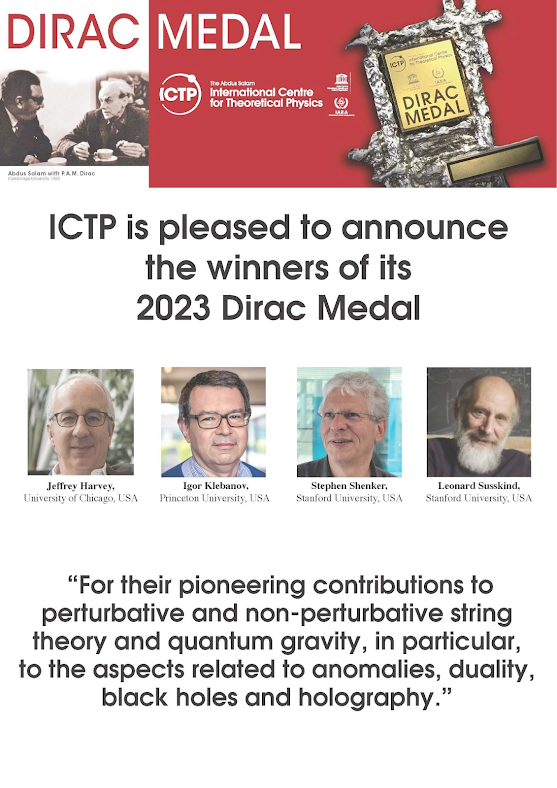Βραβείο DIRAC 2023
To ICIP (Κέντρο Θεωρητικής Φυσικής) απένειμε το Μετάλλιο Dirac 2023 σε τέσσερις φυσικούς που έχουν συνεισφέρει σημαντικά στη θεωρία των χορδών:
Τζέφρι Χάρβεϊ, Πανεπιστήμιο του Σικάγο, ΗΠΑ
ICTP has awarded its 2023 Dirac Medal to four physicists who have made wide-ranging contributions to string theory, a mathematical framework in fundamental physics that aims to describe the entirety of the whole universe.
The 2023 Dirac Medallists are:
- Jeffrey Harvey, University of Chicago, USA
- Igor Klebanov, Princeton University, USA
- Stephen Shenker, Stanford University, USA
- Leonard Susskind, Stanford University, USA
The award cites "their pioneering contributions to perturbative and non-perturbative string theory and quantum gravity, in particular, to the aspects related to anomalies, duality, black holes and holography".
The wide-ranging contributions that this year's Dirac Medallists have made to string theory reflect the broad scope of the framework. Below is a summary of the Medallists' string theory related work.
Jeffrey Harvey (with Gross, Martinec and Rohm) discovered the heterotic string theory which naturally leads to grand unified theories that can incorporate the standard model of particle physics. His work on orbifolds (with Dixon, Vafa and Witten) provided exact world-sheet constructions of such models. He pioneered the study of solitons and branes which has played a crucial role in the discovery and understanding of duality symmetries. His work on anomaly inflow (with Callan) has found important applications in condensed matter physics.
In a foundational paper on the subject, Igor Klebanov (with Gubser and Polyakov) developed a precise dictionary for the holographic AdS/CFT correspondence. He constructed examples of holographic gravitational duals of confining gauge theories (with Strassler) which have had many applications to model building.
Stephen Shenker and Leonard Susskind (with Banks and Fischler) developed the first non-perturbative formulation of M-theory and string theory by providing a limiting procedure that describes the S-matrix.
Other influential contributions by Shenker include analysis of the phase structure of lattice gauge theories (with Fradkin), classification of unitary two-dimensional conformal field theories (with Friedan and Qiu), covariant formulation of superstring theory (with Friedan and Martinec), non-perturbative formulations of string theory in low dimensions (with Douglas), and novel connections between chaos and black holes (with Saad and Stanford).
Susskind was among the first to recognize that dual models could be interpreted in terms of strings. His other influential contributions include his work on Hamiltonian lattice gauge theories (with Kogut), baryogenesis and technicolor (with Dimopoulos), holography, and connections between complexity theory and black holes.









Σχόλια
Δημοσίευση σχολίου